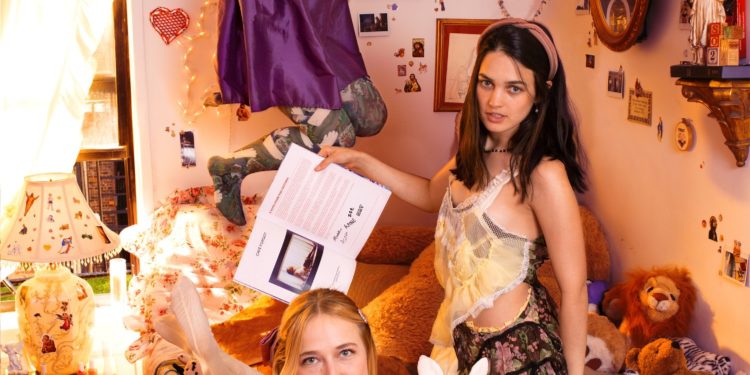AL: In terms of editorial, Madeline and I had a similar set of aesthetics. There was a total deference and trust in one another, because we had a lot of the same favorite authors and occasionally the same wrong thinkings.
NR: When I was brought into the project, I didn’t know Madeline at all. She invited me to a shared Forever album, and I texted Anika immediately like, “Did you make this on your own?”
AL: We have so much overlap.
MC: That’s how we started taking Christian iconography and appropriating it. In no way did we originate this, but I do think there are a lot of reverent ways of going about God-posting. We all came from semi-Catholic backgrounds. So, I think there’s more of an appreciation than appropriation for God and taking things to a higher power.
NR: I’m not actually religious, although I do believe in something. My family is extremely Catholic on both sides. I had the communion, but I didn’t get confirmed because I was being rebellious.
MC: I grew up in a really Lutheran community in Palos Verdes, we went to church every Sunday. I was communed and confirmed, my only real sacrament left is getting married.
AL: I was essentially raised by Satanists. I learned how to pray the rosary using an app on my iPhone, religion was my way of rebelling as a teenager.
JJ: In our subsect of LA, religious intent is easily misinterpreted. People wonder, is it newly sincere? Is it ironic? It gets muddled.
MC: The irony of it kind of depresses me, there is such art in the history of religion. I mean there’s also genocide, it’s complex. We try to come at it from a progressive standpoint, but I do think that returning to religion is a big foundation of the magazine.
AL: These girls went to Catholic school—where it’s taught to be the oldest form of morality.
MC: I was in Catholic school until the seventh grade and I remember one of my pastors saying praying is ultimately, at its core, just a form of deep attention. That’s why people find value in it, you’re solidifying your attention in one place for a long time. That is what you do for any project, essentially you’re praying.
JJ: You’re including writing that’s transgressive in a way that tests religious notions. Is there a certain message you’re trying to convey?
AL: Truth and Beauty.
MC: We need to bring up alt-lit.
AL: It’s basically the only literary tradition we had. As much as it can be seen as repetitive or deeply problematic, it makes sense as the logical conclusion of literature at the end of history.
NR: We definitely want to expand our reach beyond the alt-lit scene. Certain ideas are a big deal within that sphere, but they never make it out. We want to reach people, there’s no power when you can’t affect the broader culture.
AL: What people hate about the literature scene is that it’s a presentation of a scene without any invitation of entrance, it’s hyper-hyper locality. We would rather package and present something that’s of its time and of its place and for whoever.
MC: Ultimately, we are giving people a platform. If their work is seen as controversial at first, maybe there’s more to it, maybe there’s not.
New York Tyrant was always this great publishing model, prohibitively dense and unedited. Giancarlo DiTrapano saw something in alternative forms of literature.
AL: Our greatest ambition was to be in New York Tyrant Magazine. Even more so after Gian’s passing, we saw a cultural void that needed to be filled. No one was going to publish a bunch of Tyrant “freaks.”
JJ: There’s an oversaturation of pseudo-autistic language today. How do you navigate what’s sincere when everyone’s replicating the same tone?
AL: Ultimately, it’s the work that’s surprising and unknown that ends up being the most important and truly transgressive. I think so many people want to transgress for the sake of being neoreactionaries, and that’s not what we’re interested in. It’s about doing something new, something declarative, and taking a risk.
JJ: It sounds like you’re going to find your JT Leroy.
Credit: Source link


